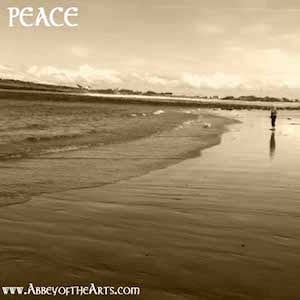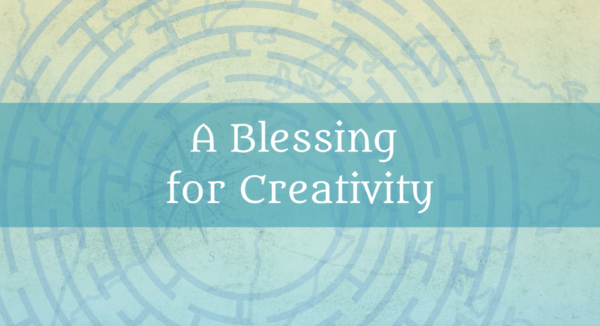This is the third in a series of eight reflections over the season of Easter on making a pilgrimage of resurrection.
Word for Today: Peace
In the gospel reading this Sunday, Jesus invites his disciples to see with new eyes. They are frightened and uncertain, because something so radically new is happening. They have grown accustomed to viewing the world in a certain way, but they are called to open their minds and their eyes in new ways.
The Gospels are filled with stories about seeing, or not seeing, as the case may be. On the road to Emmaus, a kind of pilgrimage, the disciples are walking with Jesus and breaking bread with him. We read that their “eyes were prevented from recognizing him.” When Jesus returns in resurrected form, he is fully embodied, yet hard for them to see clearly. The disciples do not expect their dear friend to be among them again and so they miss this truth with their limited vision.
 We find a similar emphasis on vision in the story of Jesus’ Transfiguration. The burning light that once appeared to Moses in the bush now radiates from Jesus himself: “His face shone like the sun.” For the ancient writer Gregory Palamas, it was the disciples who changed at the Transfiguration, not Christ. Christ was transfigured “not by the addition of something he was not, but by the manifestation to his disciples of what he really was. He opened their eyes so that instead of being blind they could see.” Because their perception grew sharper, they were able to behold Christ as he truly is.
We find a similar emphasis on vision in the story of Jesus’ Transfiguration. The burning light that once appeared to Moses in the bush now radiates from Jesus himself: “His face shone like the sun.” For the ancient writer Gregory Palamas, it was the disciples who changed at the Transfiguration, not Christ. Christ was transfigured “not by the addition of something he was not, but by the manifestation to his disciples of what he really was. He opened their eyes so that instead of being blind they could see.” Because their perception grew sharper, they were able to behold Christ as he truly is.
This speaks of an invitation to see the world in a different way. When we rush from thing to thing, never pausing, never allowing space, we see only what we expect to find. We see to grasp at the information we need. We see the stereotypes embedded in our minds. We miss the opportunity to see beyond what we want. We walk by a thousand ordinary revelations every day in our busyness and preoccupation.
We move through our lives, often at such speed, that our perception of time becomes contorted. We begin to believe that life is about rushing as fast as we can, about getting as much done as possible. We are essentially skating across life’s surface, exhausted, and disoriented.
You may have had an experience where you are moving through a most ordinary day, when suddenly something shifts. Where there was drudgery and habit, suddenly you become aware of the way sunlight is spilling across the living room rug and your heart breaks open at the splendor of it all. Or you see a loved one in a new way and revel in their beauty. Or maybe it is as simple as savoring the steam rising from your morning coffee like incense lifting the longings of your heart.
Contemplative practice calls us to change our perspective and awaken to a different reality, one that is governed by spaciousness, slowness, stillness, and presence. Contemplation invites us to tend the moments and see what is there, rather than what we expect.
Moments are holy doorways where we are lifted out of time and we encounter the sacred in the most ordinary of acts. Moments invite us to pause and linger because there is a different sense of time experienced. Moments are those openings we experience, where time suddenly loses its linear march and seems to wrap us in an experience of the eternal.
We are called to open ourselves to these moments of eternity, or better yet, how we allow the moment to find us. We only need to make ourselves available to them, to receive them as the gifts that they are, rather than seek them out as something we are entitled to have.
Our habitual ways of perceiving the world, which help us navigate things like stopping at a red light or stop sign, also stand in the way of seeing the world in fresh and new ways. So often, we are looking for information, rather than truly seeing.
I find inspiration in the ancient practice of lectio divina, or sacred reading. In lectio, we read scripture and listen for what word or phrase is shimmering. This practice is always in service of contemplative vision in daily life. Lectio invites us to slowly see more and more of the world as a sacred text, ripe with possibility for meaning. We can expand our contemplative practice to include a kind of visio divina, or sacred seeing, where we gaze on an icon or painting we love and look for something that shimmers – perhaps a symbol, a color, a brushstroke, the play of light and shadow. And in that shimmering we know there is a gift for us, even if we don’t fully understand its meaning in the moment.
We can then expand our practice of sacred seeing even further to include what we see all around us in our daily lives. What would it be like to move through our day, watching for what shimmers, waiting to receive these moments of revelation, and then savor them?
We are so used to moving through the world analyzing and judging, bringing our expectations to each encounter, planning for the next several steps ahead. It can feel awkward to bring ourselves fully present and draw on intuition, wisdom, and experience, rather than logic and analysis, to see what is most true. This heart-centered knowing comes through practice.
As I cultivate this practice of attending to the gifts the world has to offer me, to what shimmers, I am at the same time nurturing the opening of my own heart. Our minds harden our defenses, but the heart softens and blooms forth slowly, so that we find ourselves looking with more compassion on those who annoy us, and perhaps later, those we actively dislike, and finally those we have previously ignored and not even allowed into our line of sight.
When we discover ourselves surprised by love and grace, we come to trust what shimmers forth as gift. We receive without needing to figure things out. We begin to follow the thread of moment by moment revelation, not knowing where it leads, only embracing the call to see with eyes of the heart.
This is the gift of pilgrimage, of making a commitment to daily practice. Art-making can help us to see things in new ways. It calls us to drop below the surface of our experience and discover the new thing happening. How will you practice seeing the world with new eyes during this season of resurrection?
At Abbey of the Arts, we are inviting the community to make a commitment to practice creativity daily in celebration of my new book being released in May 2015 The Soul of a Pilgrim: Eight Practices for the Journey Within (Ave Maria Press). Please join us (details available at this post).
With great and growing love,
Christine
Christine Valters Paintner, PhD
Click here to read this post at Patheos and share with others>


